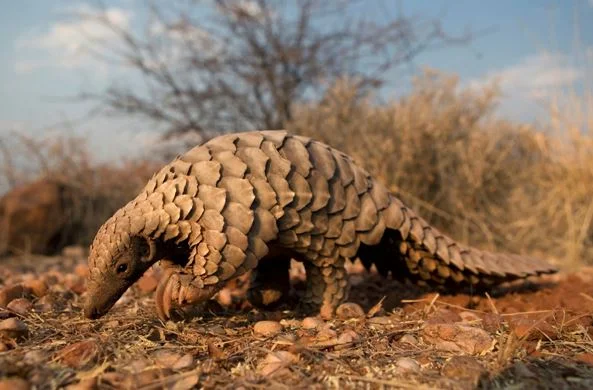A lot of people have never heard of pangolins although they have existed for around 80 million years. Many of their species in this time have become extinct, however there are eight that remain in Sub-Saharan Africa and Asia. They are often known as “Scaly Anteaters” covered in scales which overlap on their skin as a method of protection. They use their tongues to forage for food and roll into a ball when they feel threatened. With poor vision, they use their acute sense of smell to track and forage for food. Their limbs are stout, with strong claws highly adapted for digging. All pangolins belong to the genus Manis and although they share similar characteristics with (Sloths, Armadillo’s and Anteaters) they are more related to Dogs, Cats and Bears i.e. the order of Carnivora.
Pangolins have become the most trafficked animals in the world. Each remaining species of pangolin are currently either vulnerable, endangered or critically endangered. Around 300 pangolins are trafficked every day for multiple uses such as scales for traditional medicine, bush meat In Africa and a delicacy food in Asia. Poaching and trafficking are not only the threats to their survival, but deforestation of their natural habitats plays a significant factor in their extinction.
Their conservation efforts are hindered by the lack of expertise in their ecology, unknown population status and how widespread their distribution is. As a nocturnal species it has become increasingly difficult with rapidly declining numbers to study them in their natural state and only a small number of ecologists have been able to co-habitat with them. There have been several attempts in the past to reproduce pangolins in captivity, but the attempts have been unsuccessful due to their wide-range of habitats and distinct diets.
A multi-faceted process is required to help conservation efforts through multiple approaches such as:
- Higher and strengthened anti-poaching laws
- Anti-poaching tactics
- Stricter law enforcement
- Social media attention highlighting the importance and need for preservation to limit and decrease demand
In 2016 an International and National Trade Regulation agreement came into effect that was to end all illegal trade, regulate, ban and monitor pangolin trafficking. Unfortunately, there is still extensive illegal trafficking as there are beliefs that their scales can cure terminal illnesses such as cancer, making them high in demand.
Fondation Segré was the first conservation initiative established in 2015 which is committed to help and protect the biodiversity of pangolins along with conservation of their habitat, and restoration of degraded ecosystems. They are currently undergoing Operation Pluto lead by the Wildlife Justice Network and hope by 2019 they can disrupt and dismantle organised pangolin trafficking in South-East Asia. The International Union for Conservation of Nature (IUCN) has a pangolin specialist group which in 2014 launched a global conservation plan which its main aim is to drastically improve all parts of pangolin conservation with its efforts being directed towards combating illegal trafficking and poaching. They hope to increase a global awareness which tackling the problem from both sides.
Pangolins like all species on the brink of extinction are vital to our ecosystem processes. We as humans tend to look at the bigger picture, however, pangolins may play a small part but are essential to maintaining a natural cycle in their environments.
All is not lost with pangolins, although their future may seem bleak there are many organisations including those above who are diverting their efforts towards pangolins ensuring their preservation, protection and most importantly happiness.
Source: https://news.nationalgeographic.com/2016/09/wildlife-watch-most-trafficked-mammal-just-got-help/
By Earth Restoration Service Blog Writer Bianca Fogah


